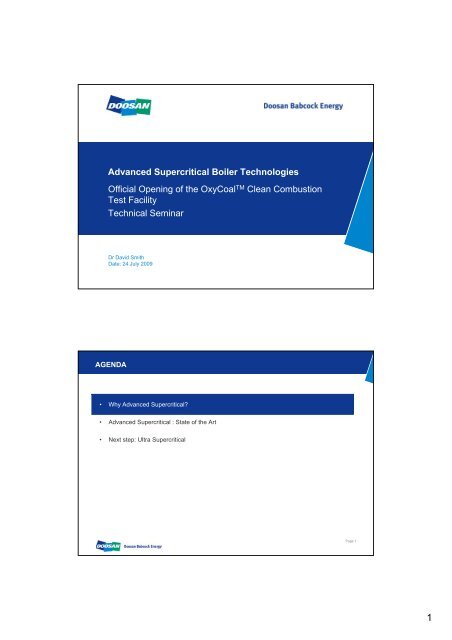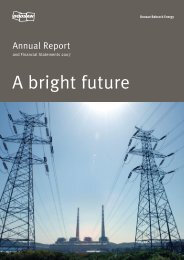Advanced Supercritical Boiler Technologies - Doosan Power Systems
Advanced Supercritical Boiler Technologies - Doosan Power Systems
Advanced Supercritical Boiler Technologies - Doosan Power Systems
Create successful ePaper yourself
Turn your PDF publications into a flip-book with our unique Google optimized e-Paper software.
<strong>Advanced</strong> <strong>Supercritical</strong> <strong>Boiler</strong> <strong>Technologies</strong><br />
Official Opening of the OxyCoal TM Clean Combustion<br />
Test Facility<br />
Technical Seminar<br />
Dr David Smith<br />
Date: 24 July 2009<br />
AGENDA<br />
• Why <strong>Advanced</strong> <strong>Supercritical</strong>?<br />
• <strong>Advanced</strong> <strong>Supercritical</strong> : State of the Art<br />
• Next step: Ultra <strong>Supercritical</strong><br />
Page 1<br />
1
WHY ADVANCED SUPERCRITICAL?<br />
CO 2<br />
Reduction<br />
- 95%<br />
Baseline<br />
TRACK 2: Carbon Capture<br />
and Storage (CCS)<br />
TRACK 1: Increased Efficiency<br />
• Both tracks are required to mitigate CO 2 emissions from coal fired generation<br />
• Primary means to increase efficiency is to increase the steam conditions we use in our power plant cycle<br />
WHY ADVANCED SUPERCRITICAL?<br />
• Efficiency of the Rankine Cycle<br />
increases with increasing Turbine inlet<br />
Temperature and Pressure<br />
• Cycle efficiency of typical sub-critical<br />
plant is 38% whereas today’s<br />
supercritical technology increases this<br />
to around 45-47%<br />
<strong>Advanced</strong> Ultra<br />
Sub-Critical Super-Critical Super-Critical Super-Critical<br />
220.89 250 290<br />
Main Steam Pressure (bar)<br />
540 570 610<br />
Main Steam Temperature (°C)<br />
Time<br />
• <strong>Supercritical</strong> means above the “critical”<br />
point for water / steam (220.89 bar) after<br />
which there is no phase change between<br />
water and steam<br />
Page 2<br />
• Other terms “<strong>Advanced</strong> <strong>Supercritical</strong>” and<br />
“Ultra <strong>Supercritical</strong>” are loose definitions to<br />
indicate steps in technology as opposed to<br />
any distinction in thermodynamic<br />
properties<br />
Page 3<br />
2
DEVELOPMENT IN THERMAL EFFICIENCY<br />
Meaningful CO 2 reductions can be achieved by replacing old units with modern advanced supercritical<br />
plant<br />
Plant<br />
efficiency<br />
% NCV<br />
55<br />
50<br />
45<br />
40<br />
35<br />
30<br />
32%<br />
UK<br />
fleet<br />
Older<br />
Plants<br />
38%<br />
Meri Pori<br />
Hemweg<br />
Sub Critical<br />
<strong>Boiler</strong>s<br />
Best Available <strong>Advanced</strong><br />
<strong>Supercritical</strong> Technology<br />
being offered now – eg<br />
Kingsnorth, Greifswald<br />
Target<br />
AD700<br />
<strong>Doosan</strong> Babcock<br />
ASC<br />
New Chinese<br />
Orders<br />
Chinese fleet 38%<br />
42%<br />
1960 1980 2000 2020<br />
STEAM CYCLE AND PLANT EFFICIENCY GAINS<br />
Efficiency (%NCV)<br />
55<br />
50<br />
45<br />
40<br />
305-585/602<br />
285-580/580<br />
275-585/602<br />
274-580/600<br />
260-540/560<br />
239-540/560<br />
50 – 55%<br />
(-29%)<br />
46%<br />
(-23%)<br />
35<br />
159-566/566<br />
166-568/568<br />
169-541/539<br />
166-568/568<br />
Main Steam Pressure (barg) – Steam Temperature Main / Reheat (°C)<br />
30<br />
1960 1970 1980 1990 2000 2010 2020<br />
Year<br />
Target<br />
AD700<br />
Year<br />
Increasing<br />
Efficiency<br />
Lower CO2 emissions<br />
<strong>Supercritical</strong><br />
<strong>Boiler</strong>s<br />
Efficiency gains have mostly been achieved by pushing the steam cycle, lower excess air and lower<br />
gas exit temperature have also contributed<br />
375-700/700<br />
Page 4<br />
Sub-Critical<br />
<strong>Supercritical</strong><br />
Page 5<br />
3
AGENDA<br />
• Why <strong>Advanced</strong> <strong>Supercritical</strong>?<br />
• <strong>Advanced</strong> <strong>Supercritical</strong> : State of the Art<br />
• Next step: Ultra <strong>Supercritical</strong><br />
WANGQU, SHANXI PROVINCE, CHINA<br />
2 x 600MWe Units<br />
Evaporation 540 kg/s<br />
S/htr Outlet Press 248 bar<br />
S/htr Outlet Temperature 571°C<br />
R/htr Outlet Temperature 569°C<br />
Contract Effective 09/03<br />
Operational 36 months later<br />
SEPARATOR<br />
VESSEL<br />
REHEATER<br />
FINAL<br />
SUPERHEATER<br />
PLATEN<br />
SUPERHEATER<br />
TO STORAGE<br />
VESSEL<br />
HOPPER KNUCKLE<br />
MAIN STEAM<br />
OUTLET<br />
FURNACE ACCESS DOOR<br />
WATER<br />
IMPOUNDED<br />
HOPPER<br />
REHEATER<br />
OUTLET<br />
ECONOMISER<br />
Pr ep ar ed by Te rry E van s, J anu ar y 200 4 f or Wangqu<br />
Page 6<br />
REHEATER<br />
PRIMARY<br />
SUPERHEATER<br />
ECONOMISER<br />
Page 7<br />
4
DEPLOYMENT OF SUPERCRITICAL TECHNOLOGY<br />
China’s deployment of supercritical technology far outstrips other countries and regions – UK deployment is<br />
zero<br />
GREIFSWALD, GERMANY<br />
2 x 800MWe Units<br />
Evaporation 588 kg/s<br />
S/htr Outlet Press 277 bar<br />
S/htr Outlet Temperature 600°C<br />
R/htr Outlet Temperature 605°C<br />
PosiflowTM vertical tube furnace<br />
Page 8<br />
Page 9<br />
5
DEVELOPMENTS IN SUPERCRITICAL BOILERS<br />
• With a Posiflow TM furnace the supercritical<br />
down-shot boiler can be realised: combines the<br />
economic and environmental benefits of<br />
supercritical steam conditions with anthracite<br />
combustion for the first time<br />
• <strong>Doosan</strong> Babcock 2 x 600MW supercritical<br />
down-shot units for Zhenxiong, Yunnan<br />
Province, China.<br />
• Posiflow TM Best Available Technology for<br />
Once-Through boiler furnace<br />
• Lower pressure drop means lower feed-pump<br />
power and lower through-life energy<br />
consumption<br />
• Other advantages include better turn-down,<br />
simpler construction and improved availability<br />
DEVELOPMENTS IN SUPERCRITICAL BOILERS: PLANT UPGRADE<br />
• <strong>Supercritical</strong> Retrofit - existing plant can be<br />
upgraded to supercritical steam conditions with<br />
lower capital cost and more rapid timescale<br />
than new plant<br />
• New boiler within existing structure<br />
• POSIFLOW TM vertical tube low mass flux<br />
furnace<br />
• Re-use of other equipment (eg fans,<br />
airheaters, coal mills)<br />
• New HP and IP turbine<br />
• <strong>Doosan</strong> Babcock Upgrade of Yaomeng <strong>Power</strong><br />
Plant in China 2002<br />
• Owner chose not to upgrade to supercritical<br />
steam conditions…..<br />
• However, application of Posiflow TM furnace and<br />
combustion system modifications gave 10%<br />
lower coal consumption and availability of 96%<br />
Page 10<br />
Page 11<br />
6
AGENDA<br />
• Why <strong>Advanced</strong> <strong>Supercritical</strong>?<br />
• <strong>Advanced</strong> <strong>Supercritical</strong> : State of the Art<br />
• Next step: Ultra <strong>Supercritical</strong><br />
ULTRA SUPERCRITICAL<br />
<strong>Boiler</strong> concept for > 700°C<br />
Generation 550MW<br />
Overall cycle efficiency >50%<br />
Page 12<br />
Main Steam Pressure 365 bar-a<br />
Main Steam Temperature 705°C<br />
Reheat Steam Temperature 720°C<br />
Reduction in CO2 emission relative to sub-critical ~30%<br />
Page 13<br />
7
MATERIALS FOR ADVANCED STEAM CYCLES - TUBING<br />
Steam cycle based efficiency gains are constrained by the availability of suitable alloys<br />
Average Stress Rupture (MPa) (100000 Hours)<br />
300<br />
250<br />
200<br />
150<br />
100<br />
50<br />
T24<br />
T23<br />
Ferritic Alloys<br />
All available now Austenitic Alloys<br />
Super 304H, 347HFG available now<br />
Sanicro 25 available – not yet codified<br />
Steam Temperature<br />
P92<br />
Super 304H<br />
347 HFG<br />
Nickel Alloys<br />
Validation ongoing<br />
Alloy 617<br />
Sanicro 25<br />
Alloy 263<br />
Alloy 740<br />
~550°C ~600°C<br />
~650°C ~700°C<br />
0<br />
500 550 600 650 700 750<br />
Metal Temperature (°C)<br />
Page 14<br />
Note – maximum allowable temperatures are also limited by steam-side oxidation<br />
MATERIALS FOR ADVANCED STEAM CYCLES - TUBING<br />
To put that in context consider a 48mm tube operating at 700°C with a design pressure of 380 bar:<br />
Allowable Stress @ 750°C<br />
(MPa)<br />
Calculated thickness<br />
t = P.D / 2.σ (mm)<br />
HR3C<br />
Austenitic<br />
Alloy 617mod<br />
Nickel Alloy<br />
Alloy 740<br />
Nickel Alloy<br />
44.5 56.0 96.0<br />
20.5 16.2 9.5<br />
Page 15<br />
8
MATERIALS FOR ADVANCED STEAM CYCLES – HEADERS AND PIPEWORK<br />
Austenitic alloys suffer from thermal fatigue, making them less suitable for thicker wall section<br />
components<br />
Average Stress Rupture (MPa) (100000 Hours)<br />
300<br />
250<br />
200<br />
150<br />
100<br />
50<br />
T24<br />
T23<br />
Ferritic Alloys<br />
All available now<br />
Steam Temperature<br />
P92<br />
Nickel Alloys<br />
Validation ongoing<br />
Alloy 617<br />
~600°C ~650°C<br />
~700°C<br />
Alloy 263<br />
Alloy 740<br />
0<br />
500 550 600 650 700 750<br />
Metal Temperature (°C)<br />
Page 16<br />
Note – maximum allowable temperatures are also limited by steam-side oxidation<br />
MATERIALS FOR ADVANCED STEAM CYCLES – MANUFACTURING<br />
Manufacturing processes for components from new materials require extensive validation<br />
Test bending furnace wall panels in T23 material<br />
Alloy 263 pipe production Alloy 263 weld qualification<br />
Bend tests in Sanicro 25<br />
Page 17<br />
9
ULTRA SUPERCRITICAL – CYCLE OPTIMISATION<br />
• In addition to improvements in Rankine Cycle efficiency from increasing steam temperatures we can make<br />
better use of low grade heat in our power plant cycle<br />
• Feedwater heating can be optimised to reduce the quantity of high grade bled steam taken from the turbine<br />
and better utilise the low grade heat in the flue gas leaving the boiler<br />
SUMMARY<br />
• Increasing plant efficiency is fundamental to reducing all emissions including CO 2<br />
• Primary means to increase efficiency is to increase the steam pressure and temperature at the turbine<br />
inlet<br />
• This means using steam at supercritical pressures – we use terms such as “<strong>Advanced</strong> <strong>Supercritical</strong>” and<br />
“Ultra <strong>Supercritical</strong>” to indicate higher ranges of temperatures and pressures<br />
• We can make improvements to the basic once-through boiler concept like the Posiflow TM furnace to<br />
further increase efficiency and operating flexibility<br />
• <strong>Supercritical</strong> technology can be readily retrofitted to life-expired existing plant<br />
• Today’s <strong>Advanced</strong> <strong>Supercritical</strong> plant will achieve around 46-47% cycle efficiency (LHV basis) and about<br />
20% reduction in CO 2 for the same MWe output as existing sub-critical plant<br />
• Ultra <strong>Supercritical</strong> plant operating at steam temperatures above 700°C is the next step. Together with<br />
improved cycles this will achieve a plant efficiency over 50% and about a 30% reduction in CO 2<br />
compared to existing sub-critical plant<br />
• Attainment of 700°C is constrained by the availability of suitable materials for the highest temperature<br />
components and development programmes are underway<br />
Page 18<br />
Page 19<br />
10
Commercial Contact Details<br />
<strong>Doosan</strong> Babcock is committed to delivering unique and advanced supercritical<br />
boiler technologies.<br />
Steve Whyley<br />
Global Sales Director<br />
<strong>Doosan</strong> Babcock Energy<br />
11 The Boulevard<br />
CRAWLEY<br />
West Sussex<br />
RH10 1UX<br />
T +44 (0) 1293 612888<br />
D +44 (0) 1293 584908<br />
E swhyley2@doosanbabcock.com<br />
Page 20<br />
11



